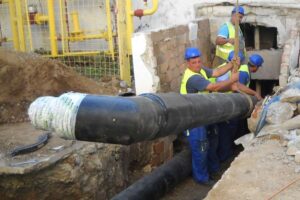 The successful renovation of the DHC network for the Otopeni Veolia (former Dalkia) project was realized in 2013, securing reliable, and affordable heating for the Otopeni community. The flexibility of the material, the ease and speed of installation through easy welding and smart use of existing infrastructure avoided interference with other networks, such as the pipelines for gas, drinkwater, sewage, and cables.
The successful renovation of the DHC network for the Otopeni Veolia (former Dalkia) project was realized in 2013, securing reliable, and affordable heating for the Otopeni community. The flexibility of the material, the ease and speed of installation through easy welding and smart use of existing infrastructure avoided interference with other networks, such as the pipelines for gas, drinkwater, sewage, and cables.
As energy in Romania is a very price-sensitive market and District Heating (DH) is in direct competition with individual forms of heating systems – mainly inefficient gas boilers – the efficiency of the DH networks is of high importance. Disconnection rates have shown a significant rise a decade ago as the natural gas price was set at a low level, making the already degraded network even less efficient due to over dimensioning. Unlike other EU member states, Romania has no tax on CO2, thus the market balance is heavily distorted to the disadvantage of district heating. However, with the natural gas price increasing over recent years, as well as the awareness to more sustainable energy economies, centralized networks are becoming of greater importance, and the Otopeni project surely is a milestone in working towards this.
 Details
Details
Existing concrete ducts that were created in the 80’s were used to slide flexalen sections through the narrow space. As Flexalen uses pre-calculated electrofusion welding, that could be done outside the trenches, the installation was swift and easy with no need to install direction changing fittings. This avoided breaking roads or even disturbing traffic, unlike pre-insulated steel applications, which require extra holes for welding and positioning procedures. Naturally, the shortest path was always chosen between interconnection points, saving significant cost and space.
Goals
Interconnection of heating stations and rehabilitation of existing heating networks at a minimum of human capital and time cost was focused at a maximum efficiency of heat distribution.
 Results
Results
Efficiency
- costs of installation reduced by 75% compared to the classical installation costs of steel pre-insulated pipes. Due to an increased speed of installation (± 3-4 times faster than the classic system) the reduction of fuel usage for heavy machinery; polifusion head to head welding or electro-fusion methods
- 40% savings on total investment costs throughout the reduction of necessary manpower and the elimination of consumables unnecessary in the welding of PB pipes
- Pressure tests with water at 8 bar maintained for 2 hours and 24 hours with air at 4,5 bar pressure showed no pressure loss due to realiability of the Flexalen PB pipes system
- Limitation of areas of exposure to risks and discomfort
Environmental
- The optimal path of the trenches avoided affecting trees, bushes or floral zones due to flexible alternations and curves
- Major cut in carbon emissions – 2.083 tons of CO2 emission saved yearly (814 tons due to network renovation)
- Reduction of fuel usage for heavy machinery
- Yearly economies in water between 11.000 – 12.000 m3
Additional Info
Download the project report
Visit Thermaflex website